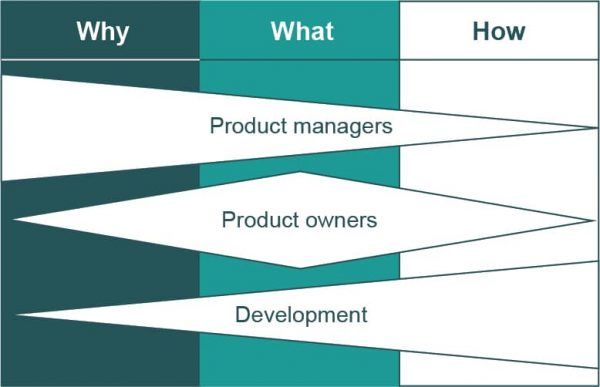 If you’re a Product Manager wondering how to get the most from Agile and Scrum, here’s a list of 5 key areas to focus on.
If you’re a Product Manager wondering how to get the most from Agile and Scrum, here’s a list of 5 key areas to focus on.
1. Product Manager vs. Product Owner?
One of Agile’s key aspects is that the development team must work closely with someone who understands what the customers want for the product. The role is critical to driving what is developed. In Scrum, this role is called the Product Owner and involves prioritizing the backlog of requirements, answering day-to-day questions, and providing signoffs and feedback. Done properly, it takes a large commitment of effort and time.

Adapted from the Agile roles framework created by Paul Inness, using the Golden Circle by Simon Sinek
As a Product Manager, you may do the Product Owner role, work with a Product Owner, or be a Product Owner who also does product management activities.
One way to separate the different roles is to look at their focus on requirements, Why, What, and How. The Product Manager will be concerned to a large degree with Why a requirement is important, based for example, on its fit with strategy, value to customers, value to the business, and competitive positioning. The Product Owner will work on the details of What is required and will, to a lesser degree, worry about why each requirement is important and how it will be built. The development team needs business and market context, but most of their focus will be on how to build the requirement and then get on with it.
The reality is that some businesses only have the Product Owner or the Product Manager role. But if both roles exist, they must be aligned on who does what and the product’s priorities. Typically the Product Manager has a high-level view of strategy and epic level requirements, while the Product Owner works on the detailed requirements and engagement with development. To do this effectively, both need to understand customers and users.
2. Know your market and set expectations
Development may be capable of updating products after every sprint, but there are markets where product updates carry significant work, major risk, or regulatory implications for customers. In markets like these, such as pharmaceuticals, banking, or telecoms, customers won’t be able to accept new product updates frequently. Instead, they need to test products and train staff before starting to use a new release.
Even if customers can accept frequent releases, a program of re-education will be needed if they’ve become used to seeing long term, detailed product roadmaps from their vendors. They need to be sold on the flexibility Agile brings, which also means acknowledging uncertainty over the detail of what they will get in each release.
The trick is the careful management of what’s being delivered and communicated to your customers. You need to control what is released, when to release it and when to talk about it.
3. Manage internal stakeholders
Our internal stakeholders, just like our customers, value certainty – so they know what’s coming and can plan accordingly. While Waterfall development approaches try to achieve certainty in roadmap delivery, the reality, even with significant resources committed to planning, is that this is very difficult to achieve. Agile recognizes this, and rather than the illusion of certainty, it offers the promise of flexibility.
It’s key that senior stakeholders and the other teams around the organization who are critical to product success (such as marketing, support, and operations) recognize this.
While there is uncertainty, it is still possible to create and communicate roadmaps and plans. One option is to focus less on features (i.e., we build this functionality) and more on the outcomes we’ve enabled for customers (e.g., shorten browsing time for people choosing a movie by 20% – for the Product Manager of a streaming movie provider). As with customers, there is a continual education process needed to sell people on the value of being flexible and accepting of the compromise of not knowing precisely what will be delivered.
4. Find customers to work with
 The beauty of Agile is how changes in product development direction can be easily accommodated by re-prioritizing the product backlog for the next iteration. To take advantage of this, you need feedback from customers and users to check you are on track. If possible, you should be setting up an early-adopter program to recruit customers who are keen to get their hands on new features in return for providing feedback.
The beauty of Agile is how changes in product development direction can be easily accommodated by re-prioritizing the product backlog for the next iteration. To take advantage of this, you need feedback from customers and users to check you are on track. If possible, you should be setting up an early-adopter program to recruit customers who are keen to get their hands on new features in return for providing feedback.
It can be a challenge finding customers to work with, so be careful to make sure the customers you choose represent the market.
5. Build credibility with development
When you are in daily contact with the development team, you are under the spotlight and so need to build your credibility and earn their respect. Development needs to have faith that you understand the market, have thought through the product direction and can lead the prioritization of requirements; otherwise, they might just go off and do their own thing.
So, make sure you clearly communicate your vision for the product and why things are important. Earn trust by responding to any questions in a timely fashion. And build rapport by learning about their development challenges.

